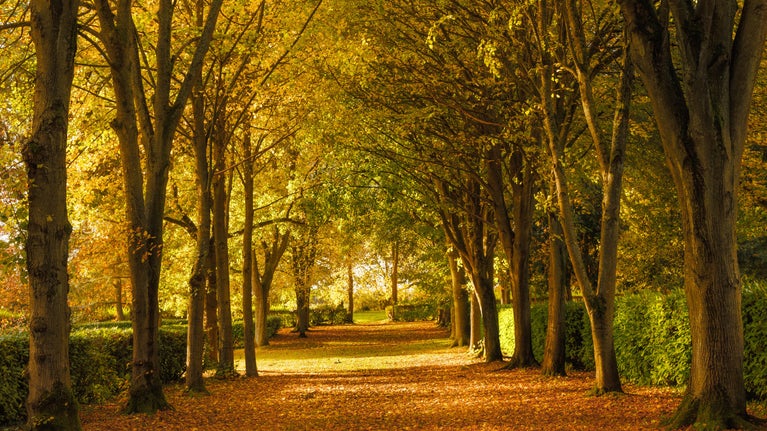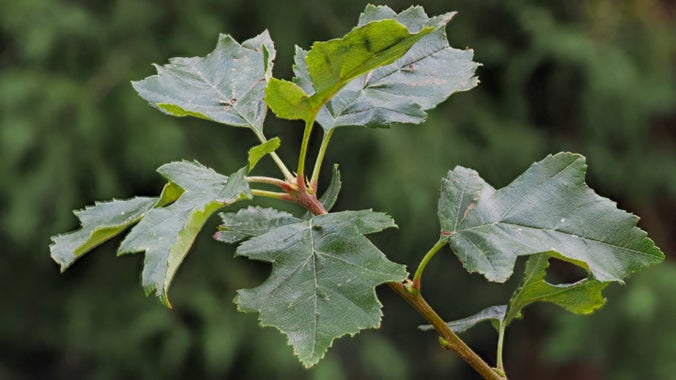‘Crumbling cloisters’ at Whipsnade Tree Cathedral World War I memorial restored for people and nature
- Published:
- 06 November 2024

Whipsnade Tree Cathedral in Bedfordshire, one of only three tree cathedrals in the UK [1], is undergoing vital conservation works to restore its natural, architectural beauty for people and nature after being devasted by ash dieback over the past five years [2].
Nestled in the rolling Dunstable Downs and cared for by the National Trust, the Grade II registered Tree Cathedral was planted after the First World War by Edmund Blyth, who served in the infantry, as a living memorial to lost comrades and friends.
Created with an array of trees, shrubs and plants, Blyth took inspiration from the structure of Liverpool’s Anglican Cathedral following a visit to the then unfinished cathedral in 1930. Planted in the shape of a traditional cathedral the nave, chancel, transepts, cloisters and side chapels are all formed by mature trees of various species including hornbeam, cypress, lime and cedar and offer a reflective space for visitors.
Much like traditional stone cathedrals, the tree filled cathedral also requires ongoing care to maintain its ‘walls’. Earlier in the year, ash trees, which formed one of two ‘cloister walks’ [3] and which had been weakened by the fungal tree disease were removed. The ash trees were part of an extension to the tree cathedral added in 1938, with the wide spacing of the trees providing plenty of light and giving an overall effect of a grand avenue.
However, this week, twelve native wild service tree saplings, which will be naturally more resistant to other diseases and tolerant to climate change, have been planted to rebuild the cloister walk. Once widespread in England, the deciduous tree species has maple-like glossy, green leaves and produces clusters of white flowers in spring followed by oval, brownish fruit.

Paul Druce-Collins, Lead Ranger for the National Trust at Dunstable Downs said: “The Tree Cathedral is an exceptional place, connecting people to nature and history. But over the last few years ash dieback has sadly made the eventual loss of the Cathedral’s ash trees, which formed part of the cloisters section – in effect a grand avenue - inevitable. Earlier this year the infected trees were felled to make way for the more resilient species of wild service trees.”
“It’s important to us to retain the structure of the Cathedral and wild service trees are ideal. They will grow to a similar size, shape and crown size as an ash tree, providing beautiful blossom in spring and vibrant colour in autumn. There aren’t any wild service trees in the Tree Cathedral at the moment, so we’re not just rebuilding ‘walls’; we’re enhancing the whole ecosystem. As they grow the new trees will help boost biodiversity by attracting pollinators, provide shelter for wildlife and help restore the Cathedral to its former glory.”
Ash dieback is a devasting disease that continues to impact the health of trees and woodlands throughout the country. With changing weather caused by a changing climate possibly exacerbating tree diseases, the conservation charity is planting more climate and disease resilient trees and creating woodlands that have a diverse range of species in them as part of their ambition to plant and establish 20 million trees by 2030.
John Deakin, the National Trust’s Head of Trees & Woodland adds: “As the climate alters, we are seeing some of our most culturally significant trees and woodlands threatened along with the connections many people have with them. Places like the Tree Cathedral remind us of our need for trees and nature as symbols of hope, celebration and remembrance and the importance of protecting them.
“This is why we ensure that when we plant or replace trees, we use more resilient species to boost nature, aid the climate and ensure opportunities for people to experience beneficial connections are nurtured for future generations.”
The felled ash trees removed from the cloisters will be repurposed as woodchip for paths on the conservation charities’ neighbouring Ashridge Estate and the stumps will be moved to the nearby Dell Fields to create valuable deadwood habitats for invertebrates such as beetles.
Whipsnade Tree Cathedral is open every day of the year, with some further conservation works ongoing until spring 2025.